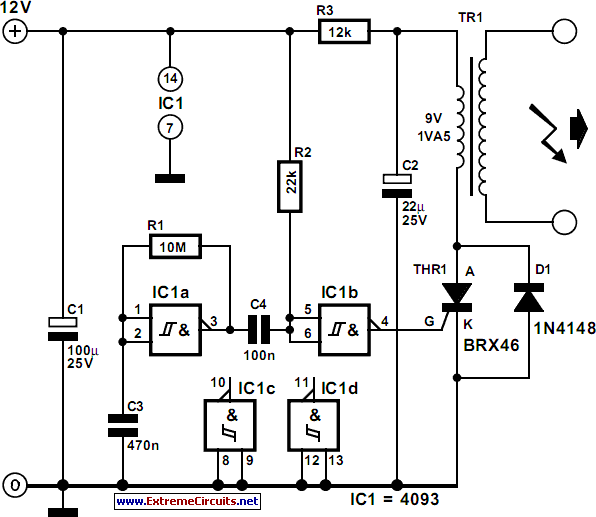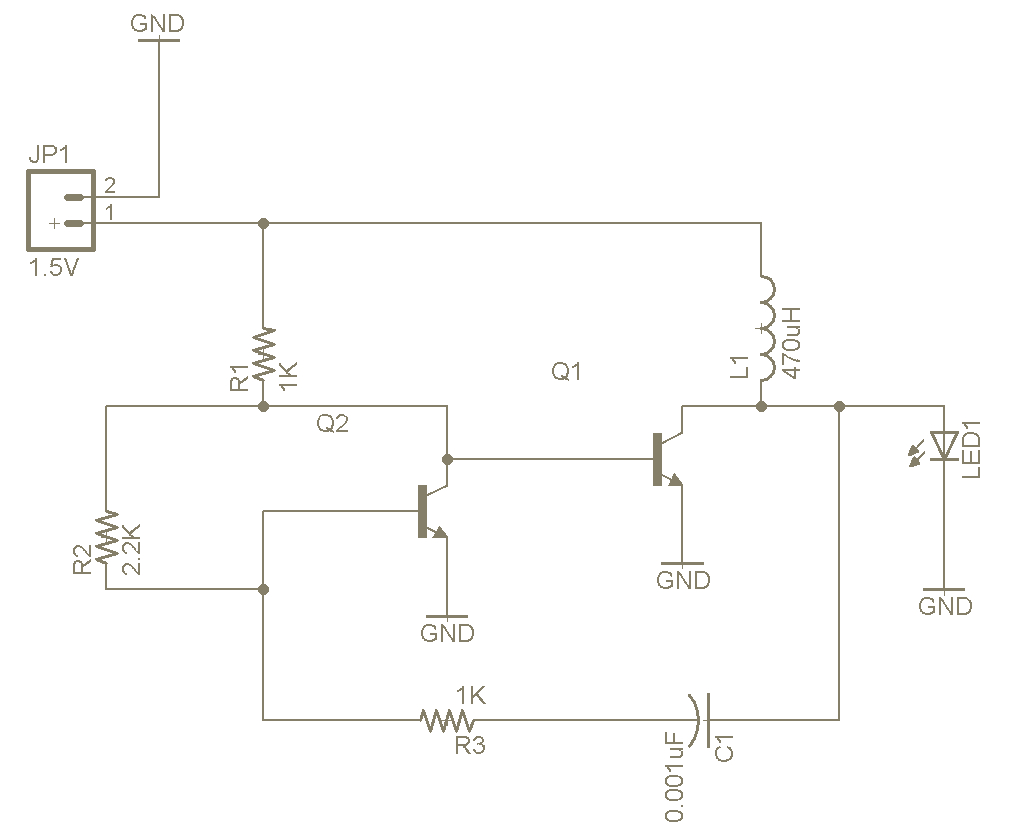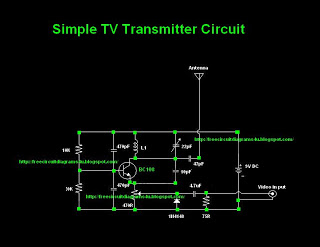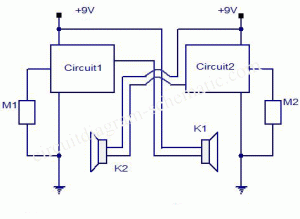
Simple Electrification Unit

The circuit is designed for conducting safe experiments with high-voltage pulses and operates similarly to an electrified fence generator. The pulse repetition frequency (PRF) is dictated by the time constant of the R1-C3 network within the feedback loop of operational amplifier IC1a, which is approximately 0.5 Hz with the specified component values. The subsequent stage, utilizing operational amplifier IC1b, transforms the rectangular signal into narrow pulses. The differentiating network R2-C4, together with the Schmitt trigger inputs of IC1b, sets the pulse period to about 1.5 ms. The output from IC1b is directly connected to the gate of thyristor THR1, enabling it to be triggered by these pulses. A small mains transformer generates the necessary high voltage, with its secondary winding functioning as the primary. This winding, in conjunction with capacitor C2, creates a resonant circuit. Capacitor C3 charges to the supply voltage of 12 V through resistor R3. When a pulse from IC1b activates the thyristor, the capacitor discharges through the secondary winding. The energy stored in the capacitor is not dissipated but is instead stored in the magnetic field of the transformer during current flow. Upon discharge of the capacitor, current flow ceases, causing the magnetic field to collapse. This collapse induces a counter electromotive force (e.m.f.) in the transformer winding, opposing the previously applied voltage. Consequently, the current maintains its direction, but capacitor C2 is charged negatively. Once the magnetic field returns the stored energy to the capacitor, the current direction reverses, and the negatively charged capacitor discharges through diode D1 and the transformer’s secondary winding. As the capacitor begins to discharge, current through the thyristor drops, causing it to turn off. Further discharge of C2 reverse-biases diode D1, breaking the current loop to the transformer, allowing capacitor C3 to recharge to 12 V via R3. This cycle repeats with each pulse from IC1b. Each triggering of the thyristor results in two closely spaced voltage pulses of opposite polarity due to the transformer inducing both primary and secondary voltages. The secondary voltage, stemming from the 230 V winding, can reach several hundred volts due to the transformer's higher turns ratio. However, the relatively small energy stored in capacitor C2 (with a current drain of approximately 2 mA) ensures that the output voltage is not harmful to humans or animals, although it can induce noticeable muscle contractions.
The circuit operates by utilizing a feedback mechanism that enables the generation of high-voltage pulses while maintaining safety. The design incorporates a feedback loop facilitated by operational amplifier IC1a, which stabilizes the pulse repetition frequency through the time constant defined by resistor R1 and capacitor C3. This configuration allows the circuit to produce a consistent output frequency suitable for experimental applications.
The transformation of the rectangular waveform into sharp pulses by operational amplifier IC1b is critical for driving the thyristor. The differentiating network formed by R2 and C4 plays a vital role in shaping the pulse width, ensuring that the output is optimized for triggering the thyristor effectively.
The use of a small mains transformer as a high-voltage generator is a noteworthy aspect of this circuit. By repurposing the secondary winding as the primary, the design achieves a compact form factor while still delivering substantial voltage. The resonant characteristics of the transformer, combined with the timing of the capacitor discharges, enable the circuit to produce dual voltage spikes, enhancing the experimental versatility.
The inclusion of diodes, such as D1, serves to manage current flow and protect the circuit components. The reverse-biasing of D1 during the discharge phase of capacitor C2 is a critical function that ensures safe operation by preventing backflow of current, thereby maintaining the integrity of the circuit.
Overall, this circuit exemplifies an efficient design approach for generating high-voltage pulses for experimental purposes, balancing performance with safety considerations. The careful selection of components and their arrangement allows for reliable operation while minimizing risks associated with high-voltage applications.The circuit is intended for carrying out harmless experiments with high-voltage pulses and functions in a similar way as an electrified fence generator. The p. r. f. (pulse repetition frequency) is determined by the time constant of network R1-C3 in the feedback loop of op amp IC1a: with values as specified, it is about 0.
5 Hz. The stage following t he op amp, IC1b, converts the rectangular signal into narrow pulses. Differentiating network R2-C4, in conjunction with the switching threshold of the Schmitt trigger inputs of IC1b, determines the pulse period, which here is about 1. 5 ms. The output of IC1b is linked directly to the gate of thyristor THR1, so that this device is triggered by the pulses.
The requisite high voltage is generated with the aid of a small mains transformer, whose secondary winding is here used as the primary. This winding, in conjunction with C2, forms a resonant circuit. Capacitor C3 is charged to the supply voltage (12 V) via R3. When a pulse output by IC1b triggers the thyristor, the capacitor is discharged via the secondary winding.
The energy stored in the capacitor is, however, not lost, but is stored in the magnetic field produced by the transformer when current flows through it. When the capacitor is discharged, the current ceases, whereupon the magnetic field collapses. This induces a counter e. m. f. in the transformer winding which opposes the voltage earlier applied to the transformer. This means that the direction of the current remains the same. However, capacitor C2 is now charged in the opposite sense, so that the potential across it is negative.
When the magnetic field of the transformer has returned the stored energy to the capacitor, the direction of the current reverses, and the negatively charged capacitor is discharged via D1 and the secondary winding of the transformer. As soon as the capacitor begins to be discharged, there is no current through the thyristor, which therefore switches off.
When C2 is discharged further, diode D1 is reverse-biased, so that the current loop to the transformer is broken, whereupon the capacitor is charged to 12 V again via R3. At the next pulse from IC1b, this process repeats itself. Since the transformer after each discharge of the capacitor at its primary induces not only a primary, but also a secondary voltage, each triggering of the thyristor causes two closely spaced voltage pulses of opposite polarity.
These induced voltages at the secondary, that is, the 230 V, winding, of the transformer are, owing to the higher turns ratio, much higher than those at the primary side and may reach several hundred volts. However, since the energy stored in capacitor C2 is relatively small (the current drain is only about 2 mA), the output voltage cannot harm man or animal.
It is sufficient, however, to cause a clearly discernible muscle convulsion. 🔗 External reference
The circuit operates by utilizing a feedback mechanism that enables the generation of high-voltage pulses while maintaining safety. The design incorporates a feedback loop facilitated by operational amplifier IC1a, which stabilizes the pulse repetition frequency through the time constant defined by resistor R1 and capacitor C3. This configuration allows the circuit to produce a consistent output frequency suitable for experimental applications.
The transformation of the rectangular waveform into sharp pulses by operational amplifier IC1b is critical for driving the thyristor. The differentiating network formed by R2 and C4 plays a vital role in shaping the pulse width, ensuring that the output is optimized for triggering the thyristor effectively.
The use of a small mains transformer as a high-voltage generator is a noteworthy aspect of this circuit. By repurposing the secondary winding as the primary, the design achieves a compact form factor while still delivering substantial voltage. The resonant characteristics of the transformer, combined with the timing of the capacitor discharges, enable the circuit to produce dual voltage spikes, enhancing the experimental versatility.
The inclusion of diodes, such as D1, serves to manage current flow and protect the circuit components. The reverse-biasing of D1 during the discharge phase of capacitor C2 is a critical function that ensures safe operation by preventing backflow of current, thereby maintaining the integrity of the circuit.
Overall, this circuit exemplifies an efficient design approach for generating high-voltage pulses for experimental purposes, balancing performance with safety considerations. The careful selection of components and their arrangement allows for reliable operation while minimizing risks associated with high-voltage applications.The circuit is intended for carrying out harmless experiments with high-voltage pulses and functions in a similar way as an electrified fence generator. The p. r. f. (pulse repetition frequency) is determined by the time constant of network R1-C3 in the feedback loop of op amp IC1a: with values as specified, it is about 0.
5 Hz. The stage following t he op amp, IC1b, converts the rectangular signal into narrow pulses. Differentiating network R2-C4, in conjunction with the switching threshold of the Schmitt trigger inputs of IC1b, determines the pulse period, which here is about 1. 5 ms. The output of IC1b is linked directly to the gate of thyristor THR1, so that this device is triggered by the pulses.
The requisite high voltage is generated with the aid of a small mains transformer, whose secondary winding is here used as the primary. This winding, in conjunction with C2, forms a resonant circuit. Capacitor C3 is charged to the supply voltage (12 V) via R3. When a pulse output by IC1b triggers the thyristor, the capacitor is discharged via the secondary winding.
The energy stored in the capacitor is, however, not lost, but is stored in the magnetic field produced by the transformer when current flows through it. When the capacitor is discharged, the current ceases, whereupon the magnetic field collapses. This induces a counter e. m. f. in the transformer winding which opposes the voltage earlier applied to the transformer. This means that the direction of the current remains the same. However, capacitor C2 is now charged in the opposite sense, so that the potential across it is negative.
When the magnetic field of the transformer has returned the stored energy to the capacitor, the direction of the current reverses, and the negatively charged capacitor is discharged via D1 and the secondary winding of the transformer. As soon as the capacitor begins to be discharged, there is no current through the thyristor, which therefore switches off.
When C2 is discharged further, diode D1 is reverse-biased, so that the current loop to the transformer is broken, whereupon the capacitor is charged to 12 V again via R3. At the next pulse from IC1b, this process repeats itself. Since the transformer after each discharge of the capacitor at its primary induces not only a primary, but also a secondary voltage, each triggering of the thyristor causes two closely spaced voltage pulses of opposite polarity.
These induced voltages at the secondary, that is, the 230 V, winding, of the transformer are, owing to the higher turns ratio, much higher than those at the primary side and may reach several hundred volts. However, since the energy stored in capacitor C2 is relatively small (the current drain is only about 2 mA), the output voltage cannot harm man or animal.
It is sufficient, however, to cause a clearly discernible muscle convulsion. 🔗 External reference





